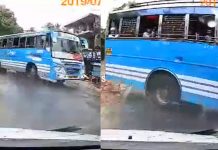Driving Scania S520 – Descending Junkerdal in Northern Norway!
This is one of the most problematic border crossing in Norway because of the steep hill and narrow road.
If you meet another truck while climbing the hill at the narrow place and it is slippery, you are pretty much screwed. Right now Norwegians are building the tunnel through the mountain to avoid that narrow part of the road which starts at 14:00.
14:05 – 21:20 This part of the road will be soon closed and replaced by the tunnel through the mountain, because it´s narrow and very steep and causes problems every winter.
An ice road (ice crossing, ice bridge) is a winter road, or part thereof, that runs on a naturally frozen water surface (a river, a lake or an expanse of sea ice) in cold regions. Ice roads allow temporary transport to isolated areas with no permanent road access. They reduce transportation cost of materials that otherwise would ship as expensive air freight, and they allow movement of large or heavy objects for which air freight is impractical.
Ice roads may be winter substitutes for summer ferry services. Ferry service and an ice crossing may operate yearly at the same time for several weeks.
While easier to drive across in the winter than land, roads over water present a great danger to anyone using them. Speeds are typically limited to 25 km/h (16 mph) to prevent a truck’s weight from causing waves under the surface. These waves can damage the road, or dislodge the ice from the shoreline and create a hazard. Another hazard on large lakes is the pressure ridge, a break in the ice created by the expansion and contraction of the surface ice due to variations in temperature.
The roads are normally the domain of large trucks (e.g. tractor-trailer units), although lighter vehicles, such as pickup trucks, even small cars, can be seen, as are snowmobiles.
Use of ice as the main construction material allows unusual construction techniques: to make a ramp to get the road over a step such as the shore of a lake, for example, lake water is pumped out and mixed with snow to make slush, formed into the shape of the ramp, and allowed to quickly freeze in the intense cold. Worn and damaged roads are repaired by flooding with shallow water that freezes into a new surface layer.



















